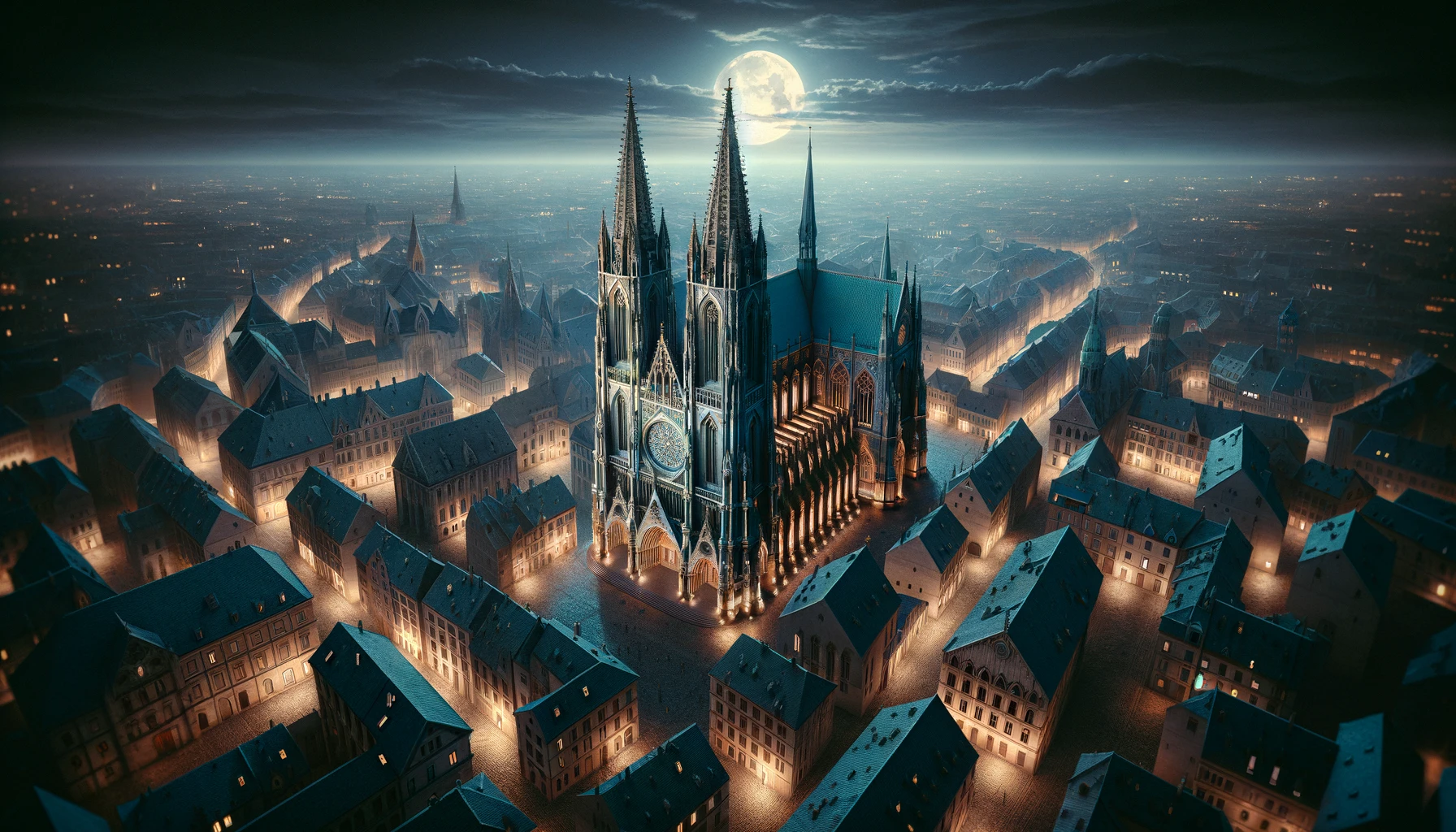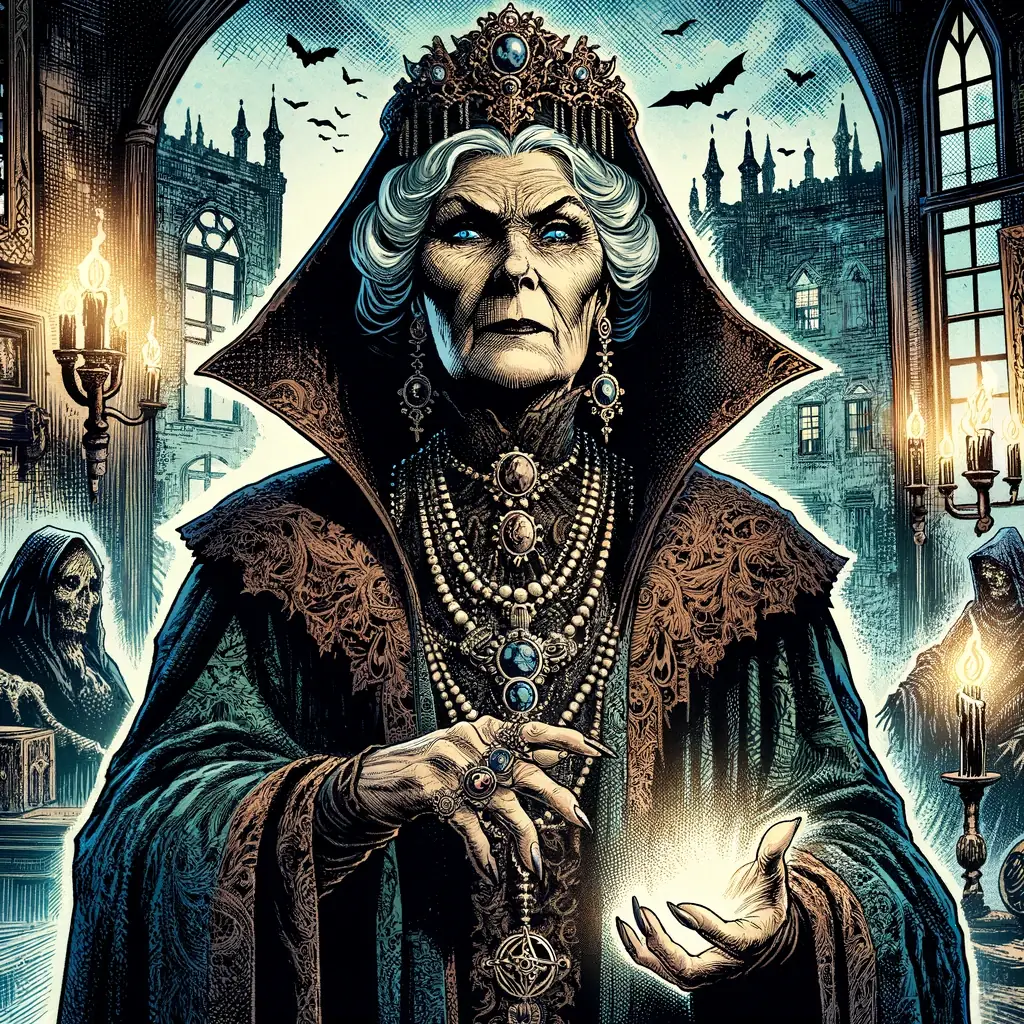
The Gothic Quarter
The Gothic Quarter is the oldest and most mysterious district of Obsidian Heights, characterized by its ancient Gothic architecture and a thick air of mystique. It is a place where history and legend intertwine, with narrow cobblestone streets leading to forgotten mansions, towering cathedrals, and secretive enclaves.
Where Whispers of the Past Haunt Obsidian’s Heart
The Gothic Quarter, a district steeped in the shadows of history and the weight of ancient secrets, stands as a silent sentinel to Obsidian Heights‘ tumultuous past. Here, amidst a labyrinth of narrow, cobbled streets and towering Gothic edifices, the boundaries between the mundane and the mystical blur, reality itself seeming to warp and twist beneath the watchful gaze of gargoyles and the silent judgment of centuries-old stone.
From Sacred Ground to Shadowed Enclave (1700s – 1850s)
Long before Jeremiah Blackwell arrived with his vision of a modern metropolis, the land that would become The Gothic Quarter was considered sacred ground. Whispers of ancient rituals and forgotten deities lingered among the gnarled oaks and mist-shrouded marshes that characterized the area. It was here, upon this hallowed ground, that the first settlers of Obsidian Heights established a small community, their lives interwoven with the rhythms of nature and the echoes of a past they could only dimly perceive.
The construction of the Cathedral of St. Morpheus, a grand edifice of soaring spires and stained glass windows that seemed to capture the city’s nascent ambition, marked a shift in the district’s character. As the city grew, so did the Cathedral’s influence, its bells tolling a constant reminder of both the promise of spiritual solace and the encroaching shadows of progress.
The Blackwell family, though primarily focused on the development of The Heights and The Nexus, recognized the symbolic importance of The Gothic Quarter. They funded the construction of the Obsidian Heights Museum of Antiquities, a repository for the city’s burgeoning collection of artifacts, both mundane and mysterious. The Museum, with its imposing neo-Gothic facade and its dimly lit halls filled with echoes of the past, became a destination for scholars, antiquarians, and those seeking to understand the city’s layered history.
As the 19th century dawned, The Gothic Quarter became a haven for those seeking respite from the relentless pace of industrialization. Writers, artists, and scholars, drawn to the district’s quiet streets and the brooding beauty of its ancient architecture, established studios and residences within its shadowed enclaves. Bellweather Manor, a grand mansion with a history as tangled as the ivy that clung to its walls, became a symbol of the district’s allure, its occupants whispered to be both patrons of the arts and practitioners of the occult.
Mysticism and Decay (1850s – 1930s)
The decline of Obsidian Heights‘ industrial fortunes, coupled with the city’s increasing fascination with obscurium and its potential to bridge the gap between science and the supernatural, cast a new light upon The Gothic Quarter. Its ancient buildings, once seen as mere relics of the past, now whispered of forgotten knowledge and hidden power.
Dame Augusta, a mysterious figure whose arrival in the district coincided with the Blackwell family’s waning influence, took up residence in Bellweather Manor, transforming it into a nexus of occult activity. Her knowledge of ancient rituals and her rumored ability to commune with otherworldly entities drew in those seeking guidance, power, or simply escape from the city’s harsh realities.
Cain’s Curios, an antique shop run by the enigmatic Victor Cain, became a destination for those drawn to the occult and the macabre. Its shelves, overflowing with peculiar objects, whispered tales of forgotten magic and whispered of the darker aspects of the city’s history.
The Museum of Antiquities, its collection now expanded to include artifacts imbued with obscurium, became a target for those seeking to unlock the mineral’s secrets. Whispers of stolen relics, secret societies meeting in its shadowed halls, and the occasional disappearance of scholars fueled anxieties and drew in those obsessed with both knowledge and power.
The Cathedral of St. Morpheus, its once-grand interior now showing signs of neglect and decay, became a refuge for those seeking solace amidst the city’s growing darkness. Its stained glass windows, depicting scenes of both spiritual devotion and unsettling imagery, seemed to reflect the duality of the district itself – a place where faith and fear intertwined, where the whispers of the past haunted the present.
By the 1930s, The Gothic Quarter remained a place of both allure and unease, its ancient streets echoing with a history that refused to be forgotten. Its residents, a mix of academics, occultists, artists, and those who sought solace in the shadows, navigated its labyrinthine alleyways, their lives entwined with the secrets that whispered from the very stones of the district itself.
the gothic quarter
Leadership
Dame Augusta
Dame Augusta, a mysterious and powerful figure, reigns over The Gothic Quarter District from her decaying mansion, Bellweather Manor. Known for her deep occult knowledge and cryptic pronouncements, she governs through secrets and mysticism, commanding both fear and respect. Her true motives and the extent of her powers remain shrouded in mystery, making her a formidable and enigmatic presence in Obsidian Heights. She operates Madame Roux’s Fortune Telling Parlor within The Luxor Hotel & Casino in The Nexus District, which serves as a front for her true occult activities.
Background
Rumored to be a powerful sorceress or occultist, Dame Augusta’s past is deliberately obscured, adding to her mystique. She has maintained her influence over The Gothic Quarter District for decades, her power solidified through a calculated blend of fear, reverence, and the strategic use of her perceived mystical abilities. While many seek her counsel, few can claim to truly know her, and her ultimate goals remain hidden in the shadows of Obsidian Heights.

Architecture
The Gothic Quarter is renowned for its imposing Gothic architecture. From the looming gargoyles to the vine-covered walls and iron lampposts, every building tells a story of the past.



Population
The population of the Gothic Quarter is diverse, including academics, occultists, aristocrats preserving old money, and lost souls seeking solace in its enigmatic atmosphere. They share a fascination with the Gothic and the hidden truths of the quarter.
Unveiling the Secrets of The Gothic Quarter
Craving a brush with the eerie and arcane? Wander into the Gothic Quarter, where every narrow street and darkened alley holds secrets older than the cobblestones beneath your feet. For a taste of history with a twist of intrigue, the Shadowed Cloister Café serves more than just coffee—it’s a meeting ground for whispers that never made it into the history books. If you’re feeling brave, step into the Vault of Echoes, where relics tell tales in hushed tones, or let Madame Nocturna read your fate under the flicker of candlelight. And for the curious with an appetite for the unnatural, The Serpent’s Rest apothecary has potions that promise answers—or questions—you never knew you had.
No posts were found.
Fashion lookbook of the district
In the Gothic Quarter, fashion embraces dark romance with a dramatic edge, echoing the elegance of a bygone era. Imagine high-necked lace blouses paired with sweeping skirts that whisper of Edwardian sophistication. The style combines structured frock coats with soft, flowing fabrics, balanced by ornate silver filigree jewelry that glints in antique gold and bone white. Colors are rich and moody—deep crimson, midnight blue, hunter green, and timeless black. Textures add depth, with plush velvet, intricate lace, and silk georgette draping like mist over the narrow, shadowed streets. Here, every outfit tells a story, blending mystery and allure for those who walk the Gothic Quarter’s hidden paths.